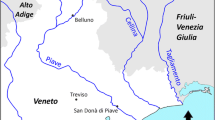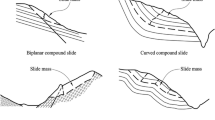Abstract
The correlation among bedrock, regolith properties, groundwater table, and slip surface character and their combined effects on the mode and scale of landslides were evaluated. Standard penetration test, laboratory, and DEM-based analyses were integrated to study igneous, metamorphic, and sedimentary areas where instability was common. A clear pattern of the distribution of translational and rotational slides, and their pre- and post-failure mechanisms were established. It was found that factors such as climate, vegetation types and density, tectonic setting, and catchment area were generally similar. The key differences were in the dissimilar underlying bedrock types which weathered to yield soils with distinctive engineering property and in the nature of the sliding surfaces. Whereas the weathering of granitic and gneissic rocks (where groundwater table was <2 m) resulted in thinner regolith composed of unsorted rock fragments, sands, and fines, the weathering of schist produced thicker soils with a high percentage of finer fractions. Sediments in areas with deeper water table (>7 m) produced less compressible, fairly-sorted, porous materials. The hydraulic conductivity of the granitic and gneissic-derived soils decreased with depth. At saturation levels above a threshold, the soils derived from the igneous and metamorphic rocks contracted and generated positive pore pressure. Movement on discrete, planar, slicken-sided, fractured, and foliated slip surfaces transformed the slides to flow (translational failures). On the contrary, pronounced dilation and negative pore-water developed in the more porous, less crushable soils from the sedimentary area leading to the dominance of rotational slumps in this region of active erosion.













Similar content being viewed by others
References
Al-Kami AA (2011) Evaluation of shear strength of cohesionless soil due to excess pore water pressure. Arab J Geosci 4(7–8):1095–1101
Chigira M, Nakamoto M, Nakata E (2002) Weathering mechanisms and their effects on the landsliding of ignimbrite subject to vapor-phase crystallization in the Shirakawa pyroclastic flow, northern Japan. Eng Geol 66(1–2):111–125
Chigira M, Wang WN, Furuya T, Kamai T (2003) Geological causes and geomorphological precursors of the Tsaoling landslide triggered by the 1999 Chi-Chi earthquake, Taiwan. Eng Geol 68(3–4):259–273
Emam A, El-Fakharani AHS, Felesteen AW, Selim SA, Hafez KM (2012) Catastrophic movement of rocks and proposed solutions to avoid its risks in the Abu El-Reesh area, northeast Aswan City, Egypt. Arab J Geosci 5(4):607–616
Fan C, Hsiao C (2012) Role of topography in the behavior of the matric suction of unsaturated fill slopes. Bull Eng Geol Environ 71(1):61–69
Fuchu D, Lee CF, Sijing W (1999) Analysis of rainstorm-induced slide-debris flows on natural terrain of Lantau Island, Hong Kong. Eng Geol 51(4):279–290
Gasmo JM, Rahardjo H, Leong EC (2000) Infiltration effect on stability of a residual soil slope. Comp Geotech 26(2):145–165
Godt JW, Baum RL, Lu N (2009) Landsliding in partially saturated materials. Geophy Res Lett 36(2):165–174
Gökceoglu C, Aksoy H (1996) Landslide susceptibility mapping of the slopes in the residual soils of the Mengen region (Turkey) by deterministic stability analyses and image processing techniques. Eng Geol 44(1–4):147–161
Guzzetti F, Mondini AC, Cardinali M, Florucci F, Santangelo M, Chang KT (2012) Landslide inventory maps: new tools for an old problem. Earth Sci Rev 112(1–2):42–66
Highland LM, Bobrowsky P (2008) The landslide handbook—a guide to understanding landslides. Reston, Virginia, US Geol Surv Circ 1325, 129p
Huang CC, Lo CL, Jang JS (2008) Internal soil moisture response to rainfall-induced slope failures and debris discharge. Eng Geol 101(3–4):134–145
Hungr O, Evans SG, Bovis M, Hutchinson JN (2001) Review of the classification of landslides of the flow type. Environ Eng Geo 7:221–238
Igwe O (2014) The compressibility and shear characteristics of soils associated with landslides in geologically different localities—case examples from Nigeria. Arab J Geosci. doi:10.1007/s12517-014-1616-3
Igwe O, Fukuoka H (2010) Environmental and socioeconomic impact of erosion in Nigeria, West Africa. Int J Eros Con Eng 3(1):102–109
Igwe O, Fukuoka H (2014) The effect of water-saturation on the stability of problematic slopes at the Iva Valley area. Southeast Nigeria Arab J Geosci. doi:10.1007/s12517-014-1398-7
Igwe O, Sassa K, Wang FW (2007) The influence of grading on the shear strength of loose sands in stress-controlled ring shear tests. Landslides 4(1):43–51
Igwe O, Fukuoka H, Sassa K (2012) The effect of relative density and confining stress on shear properties of sands with varying grading. Geotech Geol Eng 30:1207–1229
Igwe O, Fawu W, Sassa K, Fukuoka H (2013a) The laboratory evidence of phase transformation from landslide to debris flow. Geosci J. doi:10.1007/s12303-013-0049-4
Igwe O, Mode W, Nnebedum O, Okonkwo I, Oha I (2013b) The analysis of rainfall-induced slope failures at Iva Valley area of Enugu State. Nigeria Environ Earth Sci. doi:10.1007/s12665-013-2647-x
Karim A, Zitouni ZA, Arab A, Mostéfa B (2013) Identification of the behavior of sandy soil to static liquefaction and microtomography. Arab J Geosci 6(7):2211–2224
Kim J, Jeong S, Park S, Sharma J (2004) Influence of rainfall-induced wetting on the stability of slopes in weathered soils. Eng Geol 75(3–4):251–262
Lee S, Pradhan B (2006) Probabilistic landslide hazards and risk mapping on Penang Island, Malaysia. J Earth Sys Sci 115(6):661–672
Lee S, Pradhan B (2007) Landslide hazard mapping at Selangor, Malaysia using frequency ratio and logistic regression models. Landslides 4(1):33–41
Leroueil S (2001) Natural slopes and cuts: movement and failure mechanisms. Geotechnique 51(3):197–243
Nwajide C, Okogbue C, Umeji A (1988) Slump debris flows in the Akovolwo Mountains Area of Benue State. Nat Haz 1:145–154
Pradhan B, Lee S (2010a) Regional landslide susceptibility analysis using back-propagation neural network model at Cameron Highland, Malaysia. Landslides 7(1):13–30
Pradhan, Lee (2010b) Landslide susceptibility assessment and factor effect analysis: backpropagation artificial neural networks and their comparison with frequency ratio and bivariate logistic regression modeling. Environ Model Softw 25(6):747–759
Pradhan B, Youssef AM (2010) Manifestation of remote sensing data and GIS on landslide hazard analysis using spatial-based statistical models. Arabian J Geosci 3(3):319–326
Rahardjo H, Lee TT, Leong EC, Rezaur RB (2005) Response of a residual soil slope to rainfall. Can Geotech J 42(2):340–351
Sassa K (1998) Recent urban landslide disasters in Japan and their mechanisms. In: Proceedings of the 2nd International Conference on Environmental Management, Vol 1: Balkema, Rotterdam, p. 47–58
Sassa K, Wang G, Fukuoka H, Wang FW, Ochiai T, Sugiyama M, Sekiguchi T (2004) Landslide risk evaluation and hazard mapping for rapid and long-travel landslides in urban development areas. Landslides 1(3):221–235
Shoaei Z, Sassa K (1994) Basic study on the shear behavior of landslides during earthquakes. Bull Dis Prev Res Inst Kyoto Uni 44(1):1–43
Shoaei G, Sidle R (2009) Variations in soil characteristics and hydrologic properties associated with historic land use near a recent landslide, Nagano Prefecture, Japan. Geoderma 153(1–2):37–51
Tsaparas I, Rahardjo H, Toll DG, Leong EC (2002) Controlling parameters for rainfall-induced landslides. Comp Geotech 29(1):1–27
Yamazaki S, Chigira M (2011) Weathering mechanisms and their effects on landsliding in pelitic schist. Earth Surf Proc Land 36(4):481–494
Acknowledgments
This research was carried out as part of World Centre of Excellence (WCoE) Project approved for the Department of Geology, University of Nigeria by the International Program on Landslides under the leadership of my supervisor Professor Kyoji Sassa of Kyoto University, Japan. The support offered by fellow WCoE members during the 3rd World Landslide Forum in China is highly appreciated.
Author information
Authors and Affiliations
Corresponding author
Rights and permissions
About this article
Cite this article
Igwe, O. The influence of bedrock geology and slip surface characteristics on failure mode and mobility: a comparative study of instability patterns in Nigeria. Arab J Geosci 8, 9831–9844 (2015). https://doi.org/10.1007/s12517-015-1918-0
Received:
Accepted:
Published:
Issue Date:
DOI: https://doi.org/10.1007/s12517-015-1918-0




